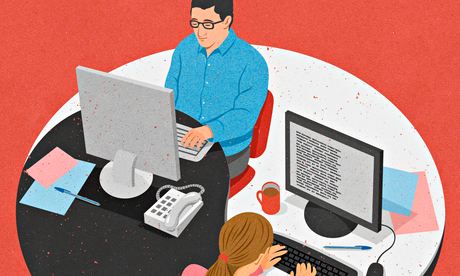
Earlier this year, the Manhattan advertising firm the Barbarian Group unveiled its "superdesk": one huge, continuous single desk for all 125 staff, which it describes as "4,400 square feet of undulating, unbroken awesomeness to keep people and ideas flowing". Its surface swoops upwards into archways, creating nooks underneath for meetings, down to sitting height, then up again, so employees can work standing up. Like many such office innovations, it's tremendously forward-thinking, and totally undermined by psychology research. There's overwhelming evidence that open offices are associated with lower job satisfaction; poorer interpersonal relations; worse concentration and creativity; damaged sleep, thanks to people working farther from windows; and more sickness, due to the potential for infection. Yet the open-plan idea seems too powerful to resist. How could more spontaneous interactions between workers be a bad thing? Actually, experts who have studied the matter say those off-the-cuff chats are pretty superficial, because people are self-conscious about being overheard. But never mind the data: feel that free-flowing, laid-back awesomeness!
I don't doubt Barbarian's good intentions. Indeed, office visionaries through the ages have often been sincere about wanting to improve employees' lives, according to Nikil Saval's fascinating new book, Cubed: A Secret History Of The Workplace. OK, so maybe that's not true of Frederick Winslow Taylor, who spent the late 19th century trying to make typists and clerks as efficient as the Industrial Revolution's machines. But the 1960s forefathers of open-plan, the German designers Wolfgang and Eberhard Schnelle – who dreamed up the Bürolandschaft, or "office landscape" – envisaged a place where humans might flourish. They scrapped regimented rows of desks in favour of higgledy-piggledy clusters and relaxation areas. In parallel, in the US, the Herman Miller Company was marketing its Action Office, a layout allowing people to move and collaborate. The new designs, Saval writes, were "breathing, lyrical and, above all, flexible". Ah, yes: flexible. If the book were a film, this is the point at which you'd hear the first quiet notes of foreboding in the score.
Because the "flexibility" of the modern office, Saval shows, mainly just means freedom for the most powerful forces to assert themselves. As the Bürolandschaft idea spread, the old inequalities and status markers re-emerged: "Secretaries are still pooled together, but at odd angles… The chief executives are out on the floor, but get apportioned conspicuously more space." And when the 1980s recession decimated the white-collar world, that same flexibility made it easy to close a floor or two, cramming more people into smaller spaces, giving rise to the contemporary cubicle.
"A flexible office was above all a cheap office," Saval writes. "Shrinking the company would make no dent in the planning budget, since you just had to move the desks around." The flexibility that lets a Google programmer hold a meeting over table tennis isn't so far removed from the flexibility that lets a call centre shove aside a few underperformers with barely a shift of the furniture. The factors that really seem to create freedom and flourishing at work are rather inflexible by comparison: good legal protection for employees. Strong unions. And walls.
oliver.burkeman@theguardian.com
Follow Oliver on Twitter.

